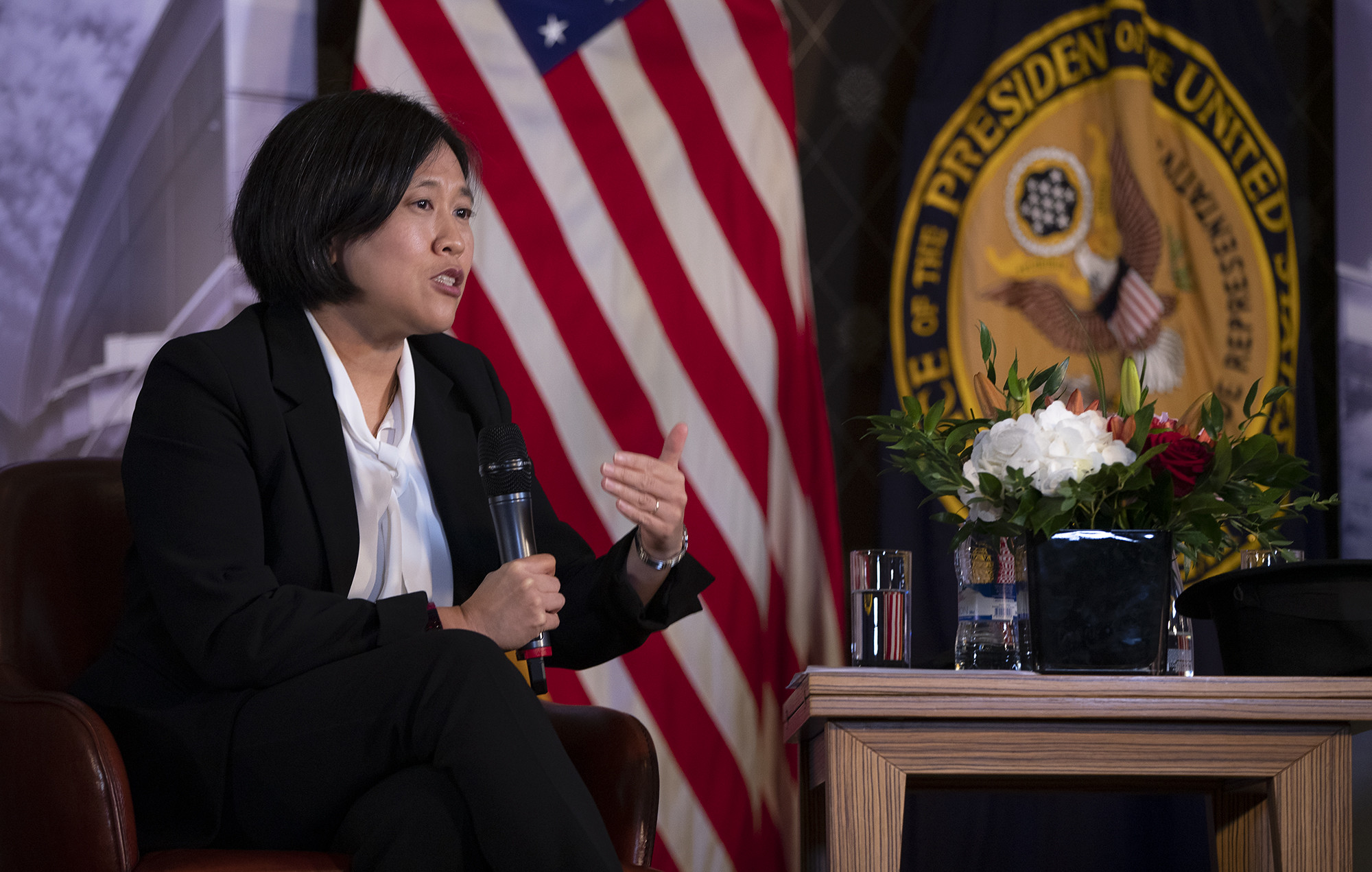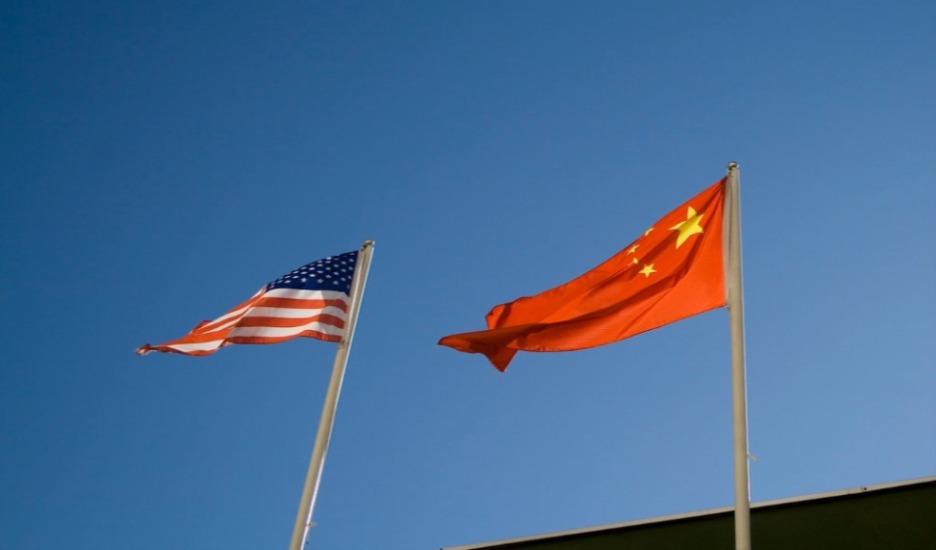Taking Stock of the New U.S. Trade Policy on China
U.S. Trade Representative Katherine Tai delivered a major speech outlining the Biden administration’s strategy to manage China’s “zero-sum” approach to global trade. Here’s what she did and didn’t say.

Published by The Lawfare Institute
in Cooperation With

The Biden administration has unveiled its long-awaited strategy for U.S.-China trade policy in a major speech delivered on Oct. 4 by U.S. Trade Representative (USTR) Katherine Tai. Though short on details, Tai’s remarks provided the outline of an overarching strategy to manage China’s “zero-sum” approach to global trade. She affirmed the administration’s broader trade priorities of negotiating from a position of strength—which necessitates substantial investments in the domestic economy—and ensuring that U.S. trade policy reinforces the well-being of workers and the resiliency of critical supply chains.
In this context, the Biden administration’s China trade policy strategy is intended to realign the economic relationship away from U.S. dependency on China and toward an equilibrium where trade is balanced and beneficial to U.S. interests. As outlined in the Oct. 4 speech, core elements of the administration’s strategy will include enforcement of China’s existing trade obligations, including in the U.S.-China Economic and Trade Agreement or “phase one” agreement; direct talks with China on issues beyond the scope of the phase one agreement; closer coordination with allies; and new policy tools to address gaps in existing trade and investment rules.
Enforcing the Phase One Agreement
The phase one agreement provides the legal framework for the flow of trade and investment between the United States and China, in addition to the commitments that each side has made under the World Trade Organization (WTO). However, the phase one agreement is not structured as a conventional trade agreement, which would traditionally include a wide range of reciprocal trade liberalization commitments that are ultimately enforceable through arbitration proceedings before an independent panel. The phase one agreement was negotiated specifically to resolve concerns identified by the United States in its 2017-2018 investigation into China’s acts, policies, and practices related to technology transfer, intellectual property and innovation, which was conducted pursuant to Section 301 of the 1974 Trade Act and is referred to as the “301 investigation.” Rather than undertaking broad market access commitments on a reciprocal basis, the phase one agreement includes specific commitments—predominantly from China—for financial services and agriculture market access, and it includes rules related to forced technology transfer, intellectual property and currency practices. These commitments are not time bound. Additionally, China committed to purchasing specific levels of goods and services from the United States over a two-year period. The phase one agreement’s dispute settlement procedures do not include an independent arbitration panel, instead permitting either side to respond to an alleged violation by “suspending an obligation under the Agreement” or “adopting a remedial measure,” if efforts to engage in consultations are not successful in bringing resolution.
This unique structure constrains the Office of the U.S. Trade Representative as the agency considers how it can enforce China’s commitments, as enforcement is necessarily limited to the specific obligations and enforcement mechanisms of the agreement. Tai has already begun to engage in consultations with China. The harder question will be what remedial measures the United States may have the legal and political space to take should the USTR assess that China is not fully meeting its obligations under the phase one agreement. Actions authorized under Section 301 are limited to a four-year period, absent a USTR determination to reinstate a case, and it may be unclear if the USTR has the authority to impose further tariffs as a “remedial measure” under the dispute resolution mechanism of the agreement.
Maintaining Existing 301 Tariffs
Tai’s remarks confirmed that the existing 301 tariffs will remain in place. Following the conclusion of the 301 investigation in 2018, the United States imposed four rounds of tariffs over the following two years, which were matched by retaliatory tariffs imposed by China, resulting in significant tariff increases across approximately half of bilateral trade flows. The former U.S. Trade Representative, Robert E. Lighthizer, has defended the tariffs as necessary to address the Chinese practices identified in the 301 investigation and to motivate companies to adjust supply chains to avoid dependencies on Chinese-sourced products. The phase one agreement prevented further tariff escalation beyond the four rounds, but it did not lead to a rolling back of the tariffs, as officials at the time contemplated further phases of negotiation. Preserving the tariff structure thus maintained negotiating leverage for the United States, while providing incentive for companies to diversify supply chains away from China. In her confirmation hearing, Tai noted that the tariffs provide negotiating leverage and has echoed many of the same strong concerns as Lighthizer regarding dependencies on China. Thus it is likely that the tariffs will remain in place for the foreseeable future, particularly if the USTR assesses that China is not meeting the obligations of the phase one agreement.
At the same time, Tai and other administration officials have expressed concern about the negative economic impacts of the tariffs domestically. To address those concerns, the USTR will initiate a process to reinstate exclusions on a limited number of tariff lines. The exclusion process will be limited to 549 tariff lines that were previously granted extended exclusion periods but that have now expired. To receive a renewed exclusion, an applicant must demonstrate that the product is available only from China, the extent of the efforts that applicants have made to procure the product from sources other than China, and the “overall impact of the exclusions on the goal of obtaining the elimination of China’s acts, policies, and practices covered in the Section 301 investigation,” among other factors. Perhaps in response to critics, including Lighthizer, who argue that reinstating an exclusions process would undermine the effectiveness of the tariff policy, this process allows the USTR to narrowly tailor the scope of reinstated exclusions.
Moving Beyond Phase One
Tai noted her intent to begin discussions with Chinese counterparts on “state-centered and non-market trade practices” that were not addressed in the phase one agreement. Concerns with China’s industrial subsidies appear likely to be at the top of the U.S. priority list, should China agree to engage. China’s subsidies are highly trade distortive, leading to excess capacity in the global markets and contributing to an erosion of U.S. industrial capacity in impacted sectors. In the semiconductor sector, the USTR estimates that China has invested $150 billion as part of its effort to reduce dependencies on foreign sources for critical chips. U.S. negotiators have attempted to address concerns with China’s subsidies dating back to its WTO accession agreement, with little success in motivating reform in this core area of China industrial policy. Today, WTO rules are largely seen as insufficient to address the full range of China’s subsidies practices.
Securing even incremental progress in bilateral talks with China will be difficult. While Tai was careful to note that her intent was “not to inflame trade tensions” with China, the broader bilateral relationship remains fraught. Although not mentioned in Tai’s remarks, the United States continues to use a wide range of defensive tools that are rightly justified by national security concerns but that can nonetheless heighten tensions, including export controls, investment screening, and new restrictions on trade and investment flows. The U.S. position may also be complicated by the growing interest in the United States for its own industrial policy, which may involve the use of subsidies and commercial incentives. While U.S. incentives are unlikely to raise the same sorts of market-distortion issues as China’s subsidies, the need for the United States to defend growing U.S. practice while creating daylight between the policies of the two sides will make for a significantly more complicated discussion.
These complications are likely part of the reason why the USTR is reportedly considering a new 301 investigation into China’s subsidies practices. A 301 investigation would allow the USTR to lay out a detailed case against China’s subsidies practices, providing the basis for unilateral action by the United States, including further tariffs. From a strategic perspective, it remains unclear whether the Biden administration has the appetite for further tariff action; and seeking relief in the WTO or in the context of bilateral talks is a difficult proposition, as noted above. The true benefit of a 301 investigation into subsidies may be to indicate to China the seriousness of U.S. concerns, to provide a structured domestic process for investigating the harm caused by China’s subsidies, and to motivate countries with similar concerns to partner with the United States in pressuring China to reduce the harmful effects of its subsidies practices.
Working With Allies
In the clearest break from the Trump administration, Tai’s remarks emphasized the need to work closely with allies. The Biden administration has already begun the work of resolving irritants in the trade relationship with key partners. Notably, the USTR negotiated agreements with the European Union and the United Kingdom to pause a long-running trade dispute over large civil aircraft. The administration is also negotiating an agreement with the EU for the removal of tariffs on steel and aluminum imports, which were imposed under national security authorities and caused significant friction in the transatlantic relationship.
Once the administration clears the decks of these issues, it can move toward deeper collaboration with allies to address China’s trade policy, as its growing work with the EU shows. The large civil aircraft agreements with the EU and the United Kingdom include plans to collaborate on subsidies issues related to China. The recently launched U.S.-EU Trade and Technology Council aims to address “non-market, trade-distortive policies and practices … [and to] improve the effectiveness of our respective domestic measures that address those policies and practices.” Prior work under the Trump administration provides insight on WTO reforms that may be of mutual interest, including outright prohibitions on the most harmful types of subsidies. These types of initiatives allow the U.S. and its allies to avoid disputes between each other and focus on joint efforts to confront China. This cooperation will be critical for any future effort under the WTO, though success in the WTO is a difficult prospect given the need for consensus among WTO members and the broader range of reforms currently needed across the WTO system.
Creating New Trade Tools
In her speech, Tai emphasized the need for new policy tools because existing trade rules are insufficient to cover the full range of Chinese trade policies that harm U.S. interests. This predominantly includes work outside the WTO. Tools implemented domestically or in conjunction with partners may be the most realistic near-term solution. For example, the large civil aircraft agreements include consideration of new policies to regulate outbound investments by U.S., EU and U.K. firms into the Chinese aerospace market. Separately, the EU has released a competition white paper on new rules for subsidized foreign investments in the EU market. These types of tools do not require agreement by China and can serve as a vehicle outside of the WTO to impose costs on China for continuing its harmful industrial policies. However, the specifics of what new tools are under consideration remain unclear.
Conclusion
Tai’s remarks reflected low but realistic expectations for how likely China is to undertake fundamental reforms. Notably absent was insight on how the administration views future trade negotiations with allies, once the president’s domestic agenda has advanced sufficiently. While negotiations with China are necessary to remedy a significant imbalance, negotiations with allies can enhance the United States’ economic integration with major trading partners, including in the Pacific region. Importantly, negotiations with friends can allow the United States to put into practice new approaches related to worker protections and supply chain resiliency, among other administration priorities. While the Biden administration has characterized its China trade policy as holistic, it is leaving out an important piece of the puzzle.


.jpg?sfvrsn=5a43131e_9)


